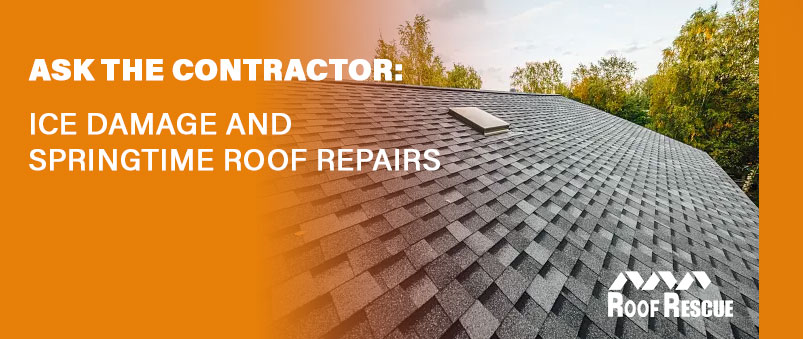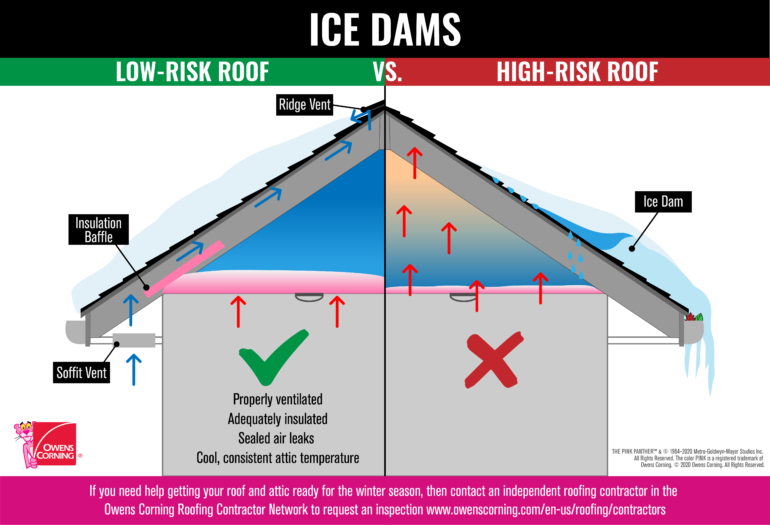
The winter is a tough time for your roof, and the spring melt is your first real opportunity for repairs. Over the winter, you may notice damage caused by piled snow, heavy ice dams, blocked gutters, and more.
If you want your roof to give the best performance over the summer and last several more years, it’s important to address spring roof repairs as promptly as possible.
The first step is understanding what’s going on with your roof and what your contractor can do in the spring to restore or replace your damaged or old roof to it’s ideal condition. Today, our team will be answering some of the more popular questions asked by homeowners in the spring.
Question 1: What is ice damming, and how does it damage roofs?
Ice damming is something often mentioned in terms of winter roof damage. But just what is an ice dam and how does it damage structural integrity of your home?
How Ice Dams Form
An ice dam occurs when ice forms at the edge of your roof, just before the gutter. This happens because the edge of your roof is the coldest part. Warm air rising from your attic and home interior will melt snow in the center and top of your roof. The cold water then runs down the shingles until it reaches the point that creates an overhang – with no warm air from below to keep it unfrozen.
What Ice Dams Do
The cold water then re-freezes as ice instead of snow, and that ice forms a mound or dam. Behind the dam, melted snow on the warmer part of the roof can accumulate.
This causes damage in two ways. First, ice dams are heavy and may weigh down your eaves and gutters. Second, water behind the dam can soak in and cause water damage to the trapped section of your roof.
Preventing Ice Dams
Preventing ice dams relies on proper insulation, soffits, and attic airflow. The goal is to ensure the entire roof is evenly heated. Insulation and ventilation can help keep those outer edges of your roof just warm enough to keep dams from forming. Clean, clear gutters to carry away snow melt are also essential.

Question 2: How can I identify if my roof has sustained ice damage?
Ice damage comes in several forms. Melted ice causes ater damage and leaks. Ice can crack your shingles, warp your underlayment, and even push or weigh down your gutters. Signs of ice damage to your roof include:
- Water stains in the ceilings or a damp attic
- This indicates that ice has formed and then melted, penetrating your roof and opening the way to water damage from the melt
- Cracked shingles
- During the winter months, ice penetration and expansion can crack and loosen shingles, leading to missing shingles that expose your roof to moisture, increasing the risk of mold growth in other areas of your home.
- Damaged gutters
- Ice dams can either weigh down your gutters and cause them to detach or push into the gutter from the roof’s edge, causing it to bend and warp away from the roof.
- Excessive Icicles
- Icicles may be pretty, but a sheet of them is a common sign of an overgrown ice dam. The icicles are caused by irregular water buildup, constantly melting and refreezing.
If you notice any concerning signs during winter or early spring, schedule a professional roof inspection. Spring inspections can prevent future water damage from ice-penetrated or damaged shingles.
Question 3: When is the best time to schedule roof repairs after ice damage?
Season changes are always the best time for roof repairs. Springtime roof repairs can help you recover from damage done during the winter from snow, ice, and winter storms. The mild weather provides easier and safer access to your roof and ensures quick drying times when new roof treatments are applied.
You can get your roof in good condition to keep you safe from spring rainstorms and ensure energy-efficiency during the summer heat.
It’s also a good idea for many homeowners to get their roof inspected and repaired in the fall. This allows you to prepare your roof for winter and enter the snowy season with your roof in the best possible condition.
Question 4: What does the roof repair process typically involve?
The spring roof repair process follows a systematic approach tailored to address the specific needs and condition of your roof.
- Inspection
- All roof repairs start with a complete inspection of your roof surface, and may include an attic inspection to see the structure and underlayment. Here, your roofers will identify any problems that might need fixing.
- Removing damaged materials
- Any damaged shingles will be removed to make way for new shingles. Shingles often split or curl in response to harsh weather.
- Replacing shingles and flashing
- Missing and removed shingles will be replaced with fresh new shingles and expertly secured. Flashing (the seal between your roof and vents or chimneys) may also be replaced if it has been damaged or come loose.
- Clean-Up
- Your roofing team will make sure debris like broken roof shingles and packing material are picked up so your house is tidy and safe when the work is done.
It is vital to work with reputable, experienced, licensed, and insured roofing professionals for each roof repair. Only verified professional roofers can provide the quality materials and work quality that you can rely on to keep your home insulated and secure.
Question 5: Are there any preventative measures to help protect my roof from ice damage?
Yes. Ice damage is more likely to occur when roofs and gutters have not been properly prepared or maintained for the region’s winter conditions. Regular roof maintenance, inspections, and region-aligned upgrades can help most homeowners avoid ice damage next winter.
- Make sure your gutters are clear and securely attached. Consider gutter guards to protect from blockages caused by autumn leaf fall or nesting animals.
- Install proper insulation and ventilation to your roof so that the entire roof surface is too warm to develop ice dams. Insulation and ventilation can also help to prevent whole-roof ice damage.
- Install ice/water shields that are specifically designed to prevent ice dams.
- Clear snow and ice buildup during the winter. A roof broom or rake can help break up deep piles that might otherwise develop dangerous re-melt situations under the surface.
Spring Roof Repair with a Contractors You Know
After an icy winter, springtime roof maintenance is essential. Ice damage can leave your roof vulnerable to water damage as snow melts and in future rain storms, and can damage your home’s energy efficiency by breaking the thermal barrier.
Now is the perfect time to schedule your exterior inspection with a professional roofing company, as summer is often the busiest time.
Contractors will inspect your damaged roof, repair any structural damage, and install your new roof using high-quality materials and expert craftsmanship, ensuring that any ice damage is promptly repaired before the next rain or summer heat waves. Get in touch with a local professional roofing contractor to further address your roof needs or springtime roof repair questions.
Here at Roof Rescue, our experienced roofers are always glad to answer questions and help clients fully understand their roofing project. If you’re looking for local roofers who understand the regional winters and the requirements of springtime roof repair for your home, contact us today.
Mark Franklin, owner of Roof Rescue in Idaho Falls, Idaho, has been a trusted name in roofing since 2014. Serving Idaho, Montana, Wyoming, and Utah, Roof Rescue specializes in commercial and residential roof replacement and installation. Recognized for community initiatives like the “Operation Roof Rescue” program, which provides free roofs to local heroes, Mark combines professionalism with a passion for giving back. With 16 years of industry experience, an A+ Better Business Bureau rating, and glowing customer reviews, Mark’s leadership embodies quality and community-focused service.



